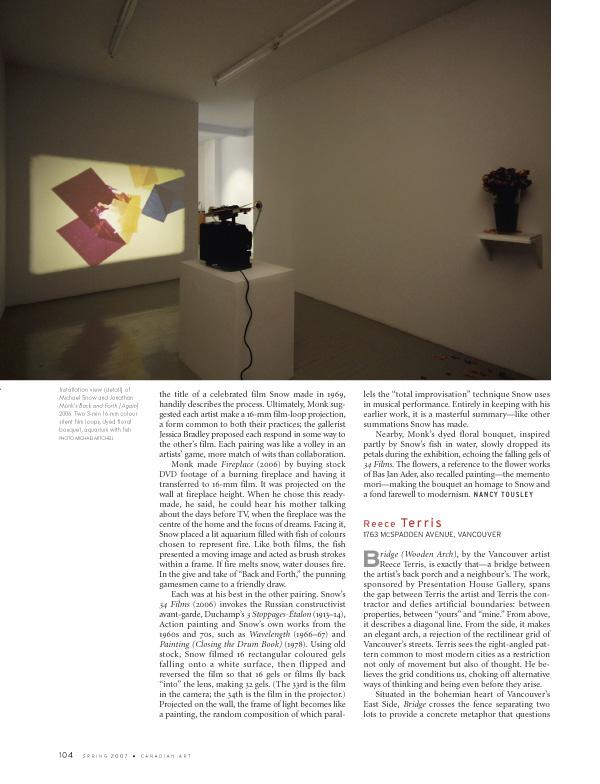Bridge (Wooden Arch), by the Vancouver artist Reece Terris, is exactly that—a bridge between the artist’s back porch and a neighbour’s. The work, sponsored by Presentation House Gallery, spans the gap between Terris the artist and Terris the contractor and defies artificial boundaries: between properties, between “yours” and “mine.” From above, it describes a diagonal line. From the side, it makes an elegant arch, a rejection of the rectilinear grid of Vancouver’s streets. Terris sees the right-angled pattern common to most modern cities as a restriction not only of movement but also of thought. He believes the grid conditions us, choking off alternative ways of thinking and being even before they arise.
Situated in the bohemian heart of Vancouver’s East Side, Bridge crosses the fence separating two lots to provide a concrete metaphor that questions arbitrary boundaries even as it breaches them. The project facilitated the friendship between Terris and his neighbours Gwendal Castellan and Tania Lo, whom he barely knew before getting their permission to build. At the opening last fall, Terris’s neighbours and friends shared his backyard with figures from Vancouver’s art scene, all craning their necks to look at the structure, most venturing across it at least once. The evening had a warm community feel, in neat contrast to a news story from one of Vancouver’s tonier residential areas, where a neighbour was objecting strongly to a tree house built by an architect for his children. If the purpose of bridges is to allow people and goods to traverse natural obstacles and connect points on a map, the purpose of Terris’s bridge is to allow playful human connection to disrupt the map.
Terris often uses construction materials as media for his art. Bridge is built from unfinished spruce two-by-fours, screws, nuts, bolts and manila rope. For a previous work, American Standard (2004–05), he installed a waterfall of urinals that overflowed into one another, flooding the men’s washroom in Simon Fraser University’s studio space—a reference to Duchamp and, less obviously, to the champagne waterfalls of society weddings. Brick (2002–03) was a wall containing brick-sized gaps through which he pushed bits of his anatomy—a weird and oddly funny piece. All testify to his imagination and capacity for hard work. So, while he builds and renovates houses, Terris also delights in deconstructing the reality he helps create.
This, perhaps, is the main function of Bridge: to open lines of communication, forge connections, remove barriers, help people come together. Like a benign virus, or a newly forged synapse, Bridge challenges the norm. It opens up new avenues for communication, connection and ideas.
This is an article from the Spring 2007 issue of Canadian Art.

 Spread from the Spring 2007 issue of Canadian Art.
Spread from the Spring 2007 issue of Canadian Art.







